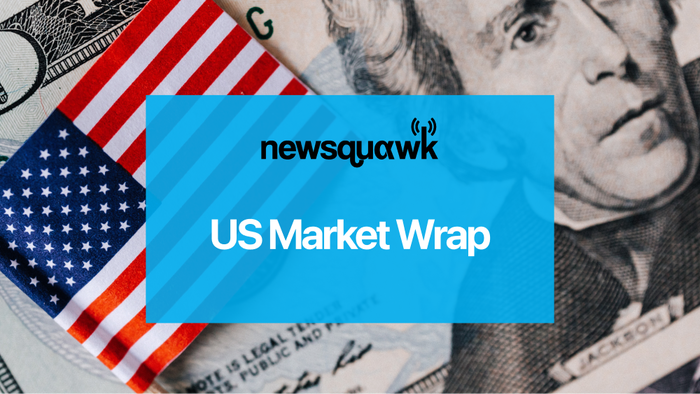
SNAPSHOT: Equities down, Treasuries flatten, Crude up, Dollar down
REAR VIEW: Fed Chair Powell reiterates post-FOMC remarks; Fed’s Bowman sees two more 25bps cuts by year end; Trump dials up the rhetoric against Russia, says Ukraine with the support of the EU can reclaim lost ground; Mediocre US 2yr note auction; French and UK PMIs disappoint, Germany beats; Riksbank unexpectedly cut rates by 25bps; Russia reportedly considering an extension to the gasoline export ban.
COMING UP: Data: Japanese PMI (Sep), Australian CPI (Aug), German Ifo Survey (Sep). Events: CNB Policy Announcement. Speakers: BoE’s Greene; Fed’s Daly. Supply: Australia, Italy, UK, Germany, US. Earnings: MediaForEurope.
More Newsquawk in 2 steps:
1. Subscribe to the free premarket movers reports
2. Trial Newsquawk’s premium real-time audio news squawk box for 7 days
MARKET WRAP
US indices closed lower, putting the recent rally on standby for now. The sector breakdown saw Energy outperform amid a rebound in crude prices; meanwhile, Consumer Discretionary and Technology lagged. NVIDIA (NVDA, -2.8%) pared some of Monday’s upside on the OpenAI deal, which was the biggest weight contributing to SPX’s 0.6% and NDX’s 0.7% decline, followed by Amazon (AMZN, -3%). US data was contained to the S&P Global Flash PMI, which largely met expectations, resulting in a muted reaction across assets. PMIs out of Europe, however, diverged. France and the UK missed while Germany beat in Services. EUR was initially weighed down by the French reading before later recovering after Germany’s reading. USD and T-Notes saw a fleeting hawkish reaction towards Fed Chair Powell’s text release on the economic outlook. The Chair mostly reiterated his recent remarks, but highlighted that most members’ base case on tariffs’ inflation impact is that it’ll be a one-time pass-through, finished by the end of next year. Other Fed speakers included the Vice Chair of Supervision, Bowman, who sees two more 25bps rate cuts, putting her in line with the FFR Fed median for 2025. The US sold USD 69bln of 2yr notes, met with mediocre demand relative to the past and six-auction average; 2yr was muted in response. In commodities, crude prices benefited from Interfax reports that Russia is considering extending its gasoline export ban. Meanwhile, gold extended into a three-day rally, supported by BBG reports that China is aiming to become a custodian of foreign sovereign gold reserves as it aims to improve its standing on the global bullion market.
US
S&P GLOBAL: S&P Global’s US Flash Manufacturing PMI for September slipped to 52.0 from 53.0, in line with expectations, while the services gauge eased to 53.9 (exp. 54.0) from 54.5, leaving the composite PMI down 1 point to 53.6. S&P said the data points to 2.2% annualised GDP growth in Q3 (note: the Atlanta Fed’s GDPnow tracker is currently modelling growth of 3.3% in Q3), though growth slowed from July and hiring weakened in September. S&P said that the softening demand was limiting pricing power, and inventories suggest downside risks to future production, yet consumer inflation is expected to remain above the Fed’s 2% target in the near term. Pantheon Macroeconomics still looks for GDP growth of “2% in Q3, followed by just ½% in Q4”.
FED
CHAIR POWELL: Powell’s remarks and tone were generally very similar to his post-FOMC meeting remarks made last week, following the Fed’s 25bps rate reduction, conveying that the Fed cut rates due to downside risks to employment. Markets saw a fleeting hawkish reaction in the wake of his initial remarks, but quickly pared back. Ahead of the Fed’s October 29th meeting, Powell said the Fed policy decision will depend on how the labour market is faring, growth, and inflation data. Powell said that policy must balance both employment and inflation goals, and he emphasised a readiness to adjust if current measures prove misaligned, while preparing for a range of possible economic outcomes. Ahead of PCE inflation data this week, Powell said that inflation has risen, with total PCE prices seen up 2.7% Y/Y (vs 2.6% Y/Y in July, and 2.3% in August 2024); Core PCE prices are expected to have increased 2.9% Y/Y (matching the July reading), driven by goods price rises, mainly reflecting tariffs. The Fed chair noted that services disinflation continues, and most long-term inflation expectations remain consistent with the 2% target, suggesting tariff-driven effects may be short-lived (Powell sees these as being a one-time pass-through, finished by the end of next year). On financial assets, Powell described equity prices as fairly highly valued, and the Fed is not targeting prices for financial assets.
BOWMAN: The Fed’s Vice Chair of Supervision backed a 25bps reduction at last week’s meeting, arguing that it is important for the Fed to now proactively support the labour market. Overall, she showed more concern towards the labour market than inflation, expressing worries that the Fed is behind the curve amid labour market weakness. Bowman described last week’s rate cut as the first step towards a more neutral rate, if the economy evolves as expected. On inflation, she said the tariff impact will fade; inflation is otherwise near target. Bowman also expressed concerns that weakness in housing could lead to a decline in values. Ahead, she said, policy could need to adjust further if risks materialise, and businesses could begin laying off people if demand conditions do not improve. Bowman backed her previous stance looking for three 25bps Fed rate cuts in 2025 (one of which we got last week), putting her line with the Fed’s median view.
GOOSLBEE: The 2025 voter said the US remains in a “low hiring, low layoffs” phase and the labour market continued to cool at a moderate pace, but job stats show stability. Goolsbee called the current policy ‘mildly restrictive’ and said that current rates exceed neutral by between 100-125bps (note: the Fed pencilled in a neutral rate of 3.0% in its projections last week). When asked about the prospects for a potentially larger 50bps rate reduction, the Chicago Fed President said the Committee must be careful about getting aggressive. Ahead, he said that interest rates may stabilise at 3% once inflation returns to 2%, and that rates could fall significantly once stagflation concerns subside.
BOSTIC: The 2027 voter said the Fed’s new policy framework remains valid and signalled openness to an inflation target range, suggesting a potential target range of 1.75-2.25%. He reaffirmed the FFR as the Fed’s main policy tool, highlighted persistent inflation risks and limited pricing power for firms, while warning that elevated inflation could cause severe repercussions. Bostic noted labour market uncertainty with firms pausing hiring or firing
FIXED INCOME
T-NOTE FUTURES (Z5) SETTLED 5+ TICKS HIGHER AT 112-28
T-notes flatten following Powell reiteration. At settlement, 2-year -0.9bps at 3.592%, 3-year -1.4bps at 3.567%, 5-year -1.9bps at 3.677%, 7-year -2.4bps at 3.868%, 10-year -2.7bps at 4.118%, 20-year -2.5bps at 4.702%, 30-year -2.5bps at 4.736%.
INFLATION BREAKEVENS: 1-year BEI -0.4bps at 3.234%, 3-year BEI +1.0bps at 2.718%, 5-year BEI +0.6bps at 2.453%, 10-year BEI 0.0bps at 2.353%, 30-year BEI +0.0bps at 2.260%.
THE DAY: Heading into remarks by Fed Chair Powell, Treasury yields were largely meandering around neutral. S&P Global reported the US flash manufacturing PMI for September slipped to 52.0 from 53.0, in line with expectations, while the services gauge eased to 53.9 (exp. 54.0) from 54.5, leaving the composite PMI down 1 point to 53.6. S&P said the data points to 2.2% annualised GDP growth in Q3 (note: the Atlanta Fed’s GDPnow tracker is currently modelling growth of 3.3% in Q3), though growth slowed from July and hiring weakened in September. S&P said that the softening demand was limiting pricing power, and inventories suggest downside risks to future production, yet consumer inflation is expected to remain above the Fed’s 2% target in the near term. Other Fed speakers didn’t really shake markets; Governor Bowman reiterated that she sees a total of three 25bps rate cuts this year. The US sold USD 69bln of 2yr notes, which resulted in a stop through of 0.1bps, with cover slightly beneath recent averages (lowest since October 2024), and at the lowest high yield since September 2024. Indirects took a higher amount than the prior, but still below recent averages, leaving direct bidders with a take-down above recent averages, while dealer participation was broadly in line with recent averages. Overall, demand was seen as average, though it caused no fanfare in markets, which at the time were fixed on remarks from Fed Chair Powell. Powell’s remarks didn’t add much by way of new information, with the Fed chair reiterating that the economy faces a challenging situation, near-term inflation risks were tilted to the upside, while employment risks were tilted to the downside. He described current rates as still ‘moderately restrictive’, defended last week’s rate cut amid slowing job growth, and noted tariffs may cause a one-time price increase spread over several quarters, potentially raising inflation temporarily. Albeit, he sees the pass-through completed by the end of the next year. Ahead of this week’s PCE inflation data on Friday, Powell said that inflation has risen, with total PCE prices seen up 2.7% Y/Y (vs 2.6% Y/Y in July, and 2.3% in August 2024); Core PCE prices are expected to have increased 2.9% Y/Y (matching the July reading), driven by goods price rises, mainly reflecting tariffs. The Fed chair noted that services disinflation continues, and most long-term inflation expectations remain consistent with the 2% target, suggesting tariff-driven effects may be short-lived (Powell sees these as being a one-time passthrough, finished by the end of next year).
SUPPLY
NOTES
US sold USD 69bln of 2yr notes.
Overall, the 2-year auction was ok, with the 0.1bps stop through welcomed, but it does signal a cooling relative to the prior stop through of 1.5bps and the six-auction average of 0.5bps. B/C fell to 2.51x from 2.69x, beneath its average of 2.1x. The demand breakdown saw dealers take more, 11.49% up from 9.7% and now above the 11.3% average, thanks to direct demand dropping to 30.77% from 33.2% (avg. 27.3%). Indirect demand was a tough higher at 57.75%, but still below the 61.4% avg.
Bills
US sold USD 85bln 6-week bills at 4.01% (prev. 4.04%), covered 2.51x (prev. 2.82x).
US to sell USD 85bln 8-week bills and USD 100bln 4-week bills on September 25th; to sell USD 65bln 17-week bills on September 24th; all to settle on September 30th.
STIRS/OPERATIONS
Market Implied Fed Rate Cut Pricing: Oct 23bps (prev. 22bps), Dec 44bps (prev. 42bps), January 55bps (prev. 54bps).
NY Fed RRP op demand at USD 14bln (prev. 14bln) across 16 counterparties (prev. 15)
EFFR at 4.09% (prev. 4.08%), volumes at USD 93bln (prev. 95bln) on September 22nd.
SOFR at 4.14% (prev. 4.14%), volumes at USD 2.906tln (prev. 2.881tln) on September 22nd.
CRUDE
WTI (X5) SETTLED USD 1.13 HIGHER AT USD 63.41/BBL; BRENT (X5) SETTLED USD 1.06 HIGHER AT USD 67.63/BBL
Crude prices gained following reports that Russia is considering extending its gasoline export ban. Initially, prices were lower by around USD 0.45/bbl before paring and moving into the green in the European morning. Behind the reversal, no clear driver was present. Thereafter, the gains extended on IFX reports that Russia is reportedly considering an extension to the gasoline export ban, putting WTI and Brent at new session highs. WTI and Brent hit session highs of USD 63.89/bbl and 68.09/bbl, respectively, before trimming some of the gains. Headlines that followed largely involved geopolitics. Iran’s Supreme Leader said negotiations with the US are a dead end, seemingly arising from Iran’s iron-clad position that it should be allowed to conduct uranium enrichment. Talks between the E3/EU/Iran Foreign Ministers have thus far yielded no positive outcome; talks are to continue; however, WSJ’s Norman writes that sources say there was nothing to suggest the meeting today made the snap back less likely to occur. Staying with geopolitics, US President Trump said NATO countries should shoot down Russian aircraft if they enter the NATO airspace and thinks the Hungarian PM will stop buying Russian oil. Ukrainian President Zelensky also spoke, noting he has good news and will brief Trump on the battlefield.
EQUITIES
CLOSES: SPX -0.55% at 6,657, NDX -0.73% at 24,580, DJI -0.19% at 46,293, RUT -0.24% at 2,458.
SECTORS: Consumer Discretionary -1.44%, Technology -1.14%, Communication Services -0.52%, Financials -0.44%, Materials -0.27%, Industrials +0.01%, Health +0.24%, Consumer Staples +0.36%, Utilities +0.54%, Real Estate +0.81%, Energy +1.71%.
EUROPEAN CLOSES: Euro Stoxx 50 +0.64% at 5,477, Dax 40 +0.40% at 23,631, FTSE 100 +0.01% at 9,228, CAC 40 +0.54% at 7,872, FTSE MIB +0.20% at 42,508, IBEX 35 +0.50% at 15,171, PSI +1.20% at 7,812, SMI -0.14% at 12,106, AEX +0.43% at 935
AutoZone (AZO): EPS missed expectations.
Sempra (SRE): To sell equity interest in SRE Infrastructure Partners for USD 10bln; affirmed 2026 profit outlook.
Firefly Aerospace (FLY): Reported a wider loss and lower revenue than expected.
Vistra (VST): Downgraded to ‘Hold’ from ‘Buy’ at Jefferies.
CoreWeave (CRWV): Upgraded at Wells Fargo to ‘Overweight’ from ‘Equal Weight’.
Symbotic (SYM): Downgraded to ‘Sell’ from ‘Neutral’ at UBS.
Johnson & Johnson (JNJ): Upgraded at Guggenheim to ‘Buy’ from ‘Neutral’.
Lam Research (LRCX): Downgraded to ‘Sector Weight’ from ‘Overweight’ at KeyBanc.
Vertiv (VRT), Eaton (ETN), and Modine (MOD) seeing downside on a Microsoft (MSFT) blog post that suggests AI chips are getting hotter; a microfluidics breakthrough goes straight to the silicon to cool up to three times better.
Eli Lilly (LLY): Plans to build a new USD 6.5bln facility to manufacture active pharmaceutical ingredients in Texas. The new site will be among those that will manufacture Orforglipron.
Disney (DIS): Raising the price of Disney Plus subscriptions from October 21st, The Verge reports.
OpenAI and Oracle (ORCL) are to announce data centre expansion in Texas, The Information reports.
Chevron (CVX) exports of Venezuelan oil have halved under new US authorisation, according to sources cited by Reuters; Exports have been effectively halved to roughly 120,000 BPD.
FX
The Dollar Index was slightly lower, weighed by strength in JPY, CHF, and EUR. S&P Global PMIs largely met expectations in September, resulting in a very muted reaction across markets. The focus, however, was on Fedspeak. Vice Chair of Supervision Bowman further expressed concerns over the labour market; however, her view on the FFR by year-end is in line with the Fed median and her previous stance. Meanwhile, Chair Powell revealed little new, once again highlighting increased risk on the labour side of the mandate and expressing that most of the committee’s base case is that tariff-driven inflation effects will be short-lived and will be finished by the end of next year. At the BoC, Governor Macklem suspects USD will remain the global reserve currency for the foreseeable future, but noted that recent US policy has dented investor confidence in the Greenback. DXY now trades at ~ 97.25 from earlier highs of 97.463.
G10FX price action was generally muted across dollar pairs. The Euro was marginally higher following mixed PMI reports out of Europe; Services and Manufacturing deteriorated more than expected in France, amid the sharpest weakening in economic activity since April. Meanwhile, a surprise expansionary reading in Germany’s Services PMI reading, 52.5 (exp. 49.5, prev. 49.3), helped EUR regain lost ground arising from the poor French figure. Later in the session, the German Institute revised its forecasts for GDP growth in 2025, now seeing 0.2% (prev. 0.1%). It kept its 2026 forecast of 1.3%, and provided an initial estimate for 2027 of 1.4%. Note, prior forecasts had factored in initial US tariffs on steel, aluminium, and cars, but not the 15% tariff on other goods. EUR/USD sits at ~1.1810, just off 1.1819 highs.
The Riksbank surprised markets with a 25bps cut, despite expectations for rates to remain at 2.0%. The central bank argued that new information has given further reassurance regarding the assessment that the high inflation is transitory, for example, companies’ pricing plans have declined, and the krona has strengthened. SEK initially came under pressure, but now sits modestly firmer against EUR on a few key developments. Firstly, Seim dissented on the decision in favour of unchanged rates and a policy path signalling some probability of a further rate cut this year. Secondly, Riksbank now views the current rate at terminal and has also revised up their GDP forecasts for 2026 and 2027
In the UK, the Flash Composite PMI reading for September fell more than expected to 51.0 (exp. 53.0, prev. 53.5), weighed by steeper declines in the Manufacturing and Services components. “The only good news is price pressures have moderated in September”, said S&P Global. Gilts and Sterling came under pressure at the time; however, Sterling recovered most of said weakness, now standing at 1.3515. Elsewhere, BoE’s Pill said they may need to maintain a restrictive monetary policy.



